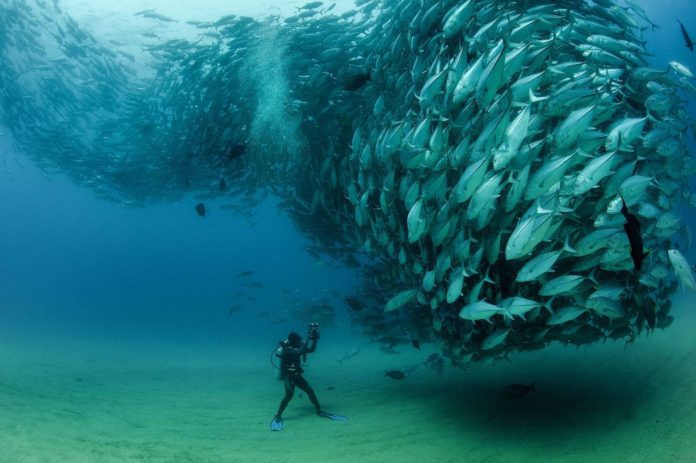The Bigeye Trevally (Caranx sexfasciatus), also known as the Bigeye Jack, is a captivating marine species known for its distinctive physical features and intriguing behaviors. Found across the tropical waters of the Indian and Pacific Oceans, this fish is a marvel both to marine biologists and avid divers alike.
Physical Characteristics
- Size and Shape: Bigeye Trevally can grow up to 120 cm in length and can weigh up to 18 kg. They have a rounder, more compressed body compared to other trevallies, with a deep body profile.
- Eyes: As their name suggests, they have notably large eyes, adapted for hunting in low-light conditions.
- Coloration: Their dorsal fin is dark with a white tip on the lobe, and they have a small dark spot on the operculum. Juveniles may display more vibrant colors, including yellow or green hues.
Habitat and Distribution
- Range: From South Africa to California, including Australia and Japan, Bigeye Trevally inhabit both shallow and deep waters, often found around coral reefs, rocky outcrops, and occasionally in estuaries.
- Depth: They roam from near the surface down to depths of about 100 meters, showing versatility in their habitat choice.
Behavior and Diet
- Schooling: These fish are known for forming large, slow-moving schools during the day, which can consist of over 1500 individuals. They become more active at night for feeding.
- Diet: Their diet shifts from crustaceans when juvenile to primarily fish as adults. They prey on a wide variety of marine life, from small fish to cephalopods and even insects like sea-skaters.
The Spectacular Mating Ritual: The Underwater Tornado
One of the most mesmerizing behaviors of the Bigeye Trevally is their unique mating ritual, where they form what is colloquially termed as an “underwater tornado” or “fish tornado.”
- Courtship Display: During certain times of the year, particularly around spawning seasons which can vary by region (July to March in some areas), these fish congregate in large numbers.
- Tornado Formation: As part of their courtship, thousands of Bigeye Trevally swim in a tight, swirling motion, creating a vortex or tornado-like structure. This behavior is thought to be both a display to attract mates and a strategic method to increase the chances of egg fertilization.
- Function: This mass aggregation not only aids in genetic diversity by mixing sperm and eggs in the water column but might also confuse predators or deter them by presenting a unified, overwhelming front.
- Visual Spectacle: Divers who witness this phenomenon often describe it as one of the most beautiful natural spectacles underwater, with the fish creating a living, spinning column that can be seen moving through the water.
Conservation and Human Interaction
- Fishing: Bigeye Trevally are of moderate importance to fisheries, valued both for commercial and recreational purposes. They are caught using various methods like gill nets, purse seines, and hook-and-line.
- Aquarium Trade: Their striking appearance makes them occasionally sought after for large public aquariums, though their size and schooling nature make them less common in home setups.
- Conservation Status: While not currently listed as endangered, sustainable fishing practices are crucial to maintain their populations.
The Bigeye Trevally, with its mesmerizing mating rituals and ecological significance, stands as a testament to the wonders of marine life. Watching a “fish tornado” is not just a visual treat but also a profound reminder of the complex behaviors that exist beneath the waves.





